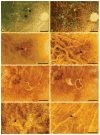Prevalence and morphology of druse types in the macula and periphery of eyes with age-related maculopathy
- PMID: 18326750
- PMCID: PMC2279189
- DOI: 10.1167/iovs.07-1466
Prevalence and morphology of druse types in the macula and periphery of eyes with age-related maculopathy
Abstract
Purpose: Macular drusen are hallmarks of age-related maculopathy (ARM), but these focal extracellular lesions also appear with age in the peripheral retina. The present study was conducted to determine regional differences in morphology that contribute to the higher vulnerability of the macula to advanced disease.
Methods: Drusen from the macula (n = 133) and periphery (n = 282) were isolated and concentrated from nine ARM-affected eyes. A semiquantitative light microscopic evaluation of 1-mum-thick sections included 12 parameters.
Results: Significant differences were found between the macula and periphery in ease of isolation, distribution of druse type, composition qualities, and substructures. On harvesting, macular drusen were friable, with liquefied or crystallized contents. Peripheral drusen were resilient and never crystallized. On examination, soft drusen appeared in the macula only, had homogeneous content without significant substructures, and had abundant basal laminar deposits (BlamD). Several substructures, previously postulated as signatures of druse biogenesis, were found primarily in hard drusen. Specific to hard drusen, which appeared everywhere, were central subregions and reduced RPE coverage. Macular hard drusen with a rich substructure profile differed from primarily homogeneous peripheral hard drusen. Compound drusen, found in the periphery only, exhibited a composition profile that was not intermediate between hard and soft.
Conclusions: The data confirm regional differences in druse morphology, composition, and physical properties, most likely based on different formative mechanisms that may contribute to macular susceptibility for ARM progression. Two other reasons that only the macula is at high risk despite having relatively few drusen are the exclusive presence of soft drusen and the abundant BlamD in this region.
Figures




References
-
- Green WR. Histopathology of age-related macular degeneration. Mol Vis. 1999;5:27. - PubMed
-
- Abdelsalam A, Del Priore L, Zarbin MA. Drusen in age-related macular degeneration: pathogenesis, natural course, and laser photocoagulation-induced regression. Surv Ophthalmol. 1999;44:1–29. - PubMed
-
- Klein R, Klein BE, Linton KL. Prevalence of age-related maculopathy. The Beaver Dam Eye Study. Ophthalmology. 1992;99:933–943. - PubMed
-
- Bressler NM, Bressler SB, West SK, Fine SL, Taylor HR. The grading and prevalence of macular degeneration in Chesapeake Bay watermen. Arch Ophthalmol. 1989;107:847–852. - PubMed
-
- Lengyel I, Tufail A, Hosaini HA, Luthert P, Bird AC, Jeffery G. Association of drusen deposition with choroidal intercapillary pillars in the aging human eye. Invest Ophthalmol Vis Sci. 2004;45:2886–2892. - PubMed
Publication types
MeSH terms
Grants and funding
LinkOut - more resources
Full Text Sources
Medical

